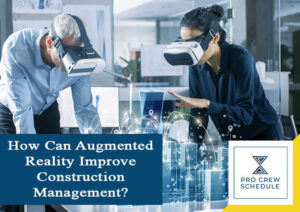Augmented reality is one of the newer innovations welcomed by the construction industry in recent years. And as the global market for AR continues to grow, it is expected to become a standardized tool in every construction company that’s aiming to improve its construction management and operations. It will complement other digital tools already used by firms, such as BIM and possibly construction management software. By augmenting 3D views on-site and imaging reports back at the office, the administration and the construction workers will be more connected and collaboration will be more effective than usual.
We’ve recently talked about how Building Information Modeling (BIM) has dramatically improved construction works’ planning stage. It detects problems in the plan and design even before the construction begins, making firms eliminate risks and avoid mistakes. However, the drawings can still be very complex and difficult to understand. Now, imagine walking through the model in real life. You can inspect the parts and systems created through BIM more up-close and see the exact spot in the site where problems may arise. Errors may then be eliminated totally during the planning stage and operations will be smoother. Consequently, there will be no more costly delays.
Now, imagine image reports delivered through augmented reality. The site’s problems will be reported in real-time through construction management software and AR can present them like the project manager is present at the site, inspecting the issues physically. How efficient can that be for a project manager who needs to urgently resolve the problem and the project team who needs to execute solutions correctly? Data can almost become tangible because of AR.
The possibilities for AR to improve construction works and remote crew management may be limitless. Today, we’re going to look into how augmented reality is changing how project managers are handling construction works and list a few AR technologies you can apply in your company.
How Augmented Reality Works in Construction
Augmented reality integrates virtual elements with a real environment, allowing people to interact with things that aren’t existing in their space. That said, the first thing we can imagine as an application of AR in construction is augmenting architectural designs into a bare construction site. It can combine a 3D model created from BIM with an existing space.
Doing so can further increase work accuracy and efficiency and reduce errors compared with referring to printed design or shared images on mobile devices. Project managers and site supervisors can have an easier time carrying out inspections. Safety engineers can quickly distinguish dangers at the site. Quality inspectors can easily evaluate works. Construction workers can be walked through their tasks more effectively. The project team can understand complex geometries and visualize difficult installations a lot better.
Overall, augmented reality is the way to more clarity, accuracy, and efficiency in construction works.
Looking further at what augmented reality can do, here are more ways on how it is improving construction management:
1. Meticulous Project Planning
Augmented reality expands the power of BIM. As BIM analyzes possible errors and risks that come with the project design, AR lets the planning team understand the plan more in-depth by projecting the end-product to the environment. Consequently, the project team can visualize how the structure will benefit its surroundings.
As you know, it is crucial to align the plan with the requirements set by the client. By using BIM and augmented reality, you won’t have to rack your brain to imagine how your plan will turn out as AR will already do the job. Morpholio is an example of AR app used by architects and project managers to put CAD models to life.
2. More Accurate Measurements
Dimensions are vital in construction works. With a definite space given for the structure, all elements should have proper sizing so they will fit into the building. The cost of materials and labor hours also rely on accurate measurements.
Using augmented reality, the project team can measure the site and elements more accurately, hence reducing risks of repeat works. The augmented reality gears developed by DAQRI and Microsoft’s Halolens serve as smart glasses that can measure a space’s depth, height, and width more precisely.
3. On-the-Spot Revisions
Even with BIM, it can still be impossible to detect all the plan’s problems, especially when the crew members can’t accurately execute their tasks. There will always be a discrepancy between the actual output and the design. But with augmented reality, one can visualize installation limits, hence minimizing rework. It can even be used to see how features dictated on the design will fit on the site so the team can make revisions and adjustments even before the work begins.
4. Faster Site Inspections
Inspections are usually done manually and can be time-consuming. Augmented reality can help save time and budget by aligning the BIM model with the actual features to quickly determine discrepancies in dimensions, looks, materials, and specifications. Some gadgets like DAQRI can even retrieve notes from the office, making inspection easier.
5. Easier Inspection of Underground Elements
There are a couple of construction elements hidden underground in modern construction, such s electrical cables and pipes. One damaged part of these systems can cause catastrophic explosions or other damages to the building. But inspecting them every now and then can be difficult as excavations may be required.
There are mobile apps, though, that can be used to see elements underground such as AugView. This AR tech uses google maps to detect trenches or buried cables.
6. More Efficient Training
Among all augmented reality applications in the construction industry, training sessions have been the first to take advantage of AR’s power. It has greatly improved training safety as newbies are taught using holographic images before dealing with the real thing. New crew members with zero experience in construction can work with large equipment without meeting an accident during the training, which often happened in the past.
Furthermore, AR eliminates the need to hire a training officer as workers can now receive direct instructions through their smart glasses. Cost and time are then saved.
7. Higher Cost Savings
As mentioned, AR can help generate savings from taking training officers out of the organization and eliminating training materials that need to be updated when new technologies are introduced.
Also discussed earlier is AR’s ability to increase efficiency at the site by integrating it with BIM and construction crew management software. It streamlines project managers’ tasks such as planning, monitoring, inspecting, scheduling, and assessing risks among many others. That said, paid manhour can be trimmed down and the project can be completed a lot faster.
Top 5 AR Innovations to Try
With the benefits as mentioned above of augmented reality in construction management, you might already be considering using the technology in your company but are confused about what innovation to try.
Devices like smart glasses are the most common innovations used to take advantage of AR’s capabilities. But there are now applications that can be installed on your mobile devices that are AR-powered.
When talking about AR devices, the Microsoft HoloLens might be the most popular. But because of its high price, builders take other alternatives.
Now, here are other apps and gadgets integrated with AR that can be useful to construction professionals.
1. Morpholio AR Sketchwalk
Installable on tabs and iPads, AR Sketchwalk gives life to architectural sketches and designs by augmenting the drawing so the client and project team can walk through growing walls. This allows clients to better visualize proposals by making presentations clearer and more interactive.
2. DAQRI Smart Helmet
DAQRI’s Smart Helmet can project 3D models in a real environment. Construction workers can then compare their output with the original design so they can immediately detect errors and repair them accordingly. Additionally, it keeps the site and office in sync by turning the workflow all-digital.
3. Measure for IOS and Android
Your simple mobile device can transform into an AR device by installing AR Measure, which can be downloaded from Google Play and Apple Store. The app works like a virtual ruler, measuring everything you focus your camera on. Other apps with a similar function include AirMeasure and MeasureKit.
4. Augment
Another AR application that can be used by construction professionals is Augment. This app projects 3D models in a real space like a hologram. It can even simulate life-size products. This makes it easier and more convincing for designers and contractors to present their ideas to clients, hence increasing their chance to land on a project.
5. GAMMA AR
Finally, we have the GAMMA AR, which is a site monitoring app used by project teams. This app uses AR to overlay 3D buildings drafted on BIM software via smart devices. It can be leveraged for comparing the actual work with the planning information, hence minimizing errors.
Final Thoughts
Augmented reality is indeed a useful technology that should be considered by construction companies. AR shouldn’t be as expensive as buying Hololens for all construction workers in your company as there are apps like those we listed above that are affordable and handy. Besides, the significant role of AR in boosting the planning stage and the tasks of monitoring, inspection, bidding, discovering and mitigating risks, and training are enough to make the investment worth it. Finally, AR is on the rise, so if you want to keep up with the competition, you should be creative in finding areas in your operation where augmented reality solutions can be useful.







